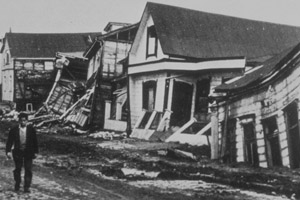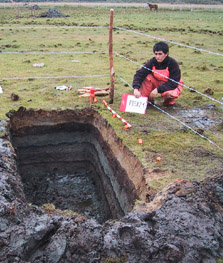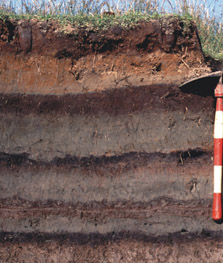|
Layers of sand in the earth have helped seismologists investigate
the history of earthquakes in Chile.
by Virginia Cooper Hughes
 Photo by Pierre
St. Amand
Photo by Pierre
St. Amand
Earthquake
damage to homes in the town of Valdivia in Chile, near the
epicenter of the earthquake.
|
|
|
In May of 1960, the largest
earthquake ever recorded rocked an idyllic seascape on the coast of
Chile. Hundreds of locals, frightened by the violent shaking of the
land, sought refuge in small boats. They thought they were safe -
until the sea roared with the 75-foot waves of the quake’s daughter
tsunami. And they weren’t the only ones who felt it – giant waves
were triggered in Japan and Hawaii, killing people and destroying
homes.
Typically, the magnitude of an
earthquake increases with the number of years since the last one in
the area. So considering its enormity, at least 350 years should
have elapsed between the Chilean quake and its immediate
predecessor. Sure enough, Spanish conquistadors wrote of a large
quake in 1575. But here’s the big mystery: other documents suggest
the 1575 quake wasn’t the last one before 1960. Two others
are documented: one in 1737 and another in 1837. This left those who
were studying the 1960 event scratching their heads to figure out
how so much energy could have built up in just 123 years.
Four decades later, a team of
international seismologists, led by Brian Atwater from the
University of Washington and Marco Cisternas from the Pontificia
Universidad Católica de Valparaíso in Chile, have finally examined
the tracks of the Chilean giant and the devastating tsunami it
caused. As revealed last September in Nature, their analysis
of the layers of earth in the coastal region has shed light upon the
long-misunderstood history of the disaster.
 Photo courtesy
of Brian Atwater
Photo courtesy
of Brian Atwater
Seismologists dug a trench in a field near the epicenter of
the earthquake to study the layers of sand.
|
The physical cause of the 1960 quake
had already been explained. One piece of the earth’s crust—the Nazca
tectonic plate—slowly slid beneath the South American continent to
its east. Though it moved just three inches per year, great amounts
of energy built up over several centuries - until May 22 when the
earth finally succumbed to the pressure. And just 15 minutes after
the resulting quake—much like the ripples a dropped stone makes on
the surface of a pond—the subterranean grind created a tsunami.
But how many centuries had passed
between earthquakes? Chilean eyewitnesses in 1960 reported that even
five miles inland, the tsunami coated the land with sand. By
assuming that each past earthquake in the area had also left behind
a sandy layer, Cisternas and Atwater could determine the number of
earthquakes by counting layers of sand in the earth.
The team spent three years digging up
the earth’s settled layers of rock and sand. In this way, they were
able to piece together a 2,000-year record of seismic history. The
results: the quake of 1575 appeared clearly in the stratigraphic
record, while those of 1737 and 1837 did not.
 Photo courtesy
of Brian Atwater
Photo courtesy
of Brian Atwater
Seismologists analysed layers of soil to see if sand from
past earthquakes may have been left behind.
|
So what about the documents of the
latter two? The team suggests neither quake caused lasting
ecological damage. After counting the trunk rings of 15 dead,
standing trees—presumed to have died in 1960—they found ten were
alive in 1837 and two in 1737. The forest damage from the earlier
quakes, then, could not have been as extensive as the havoc wreaked
in 1960.
These findings aren’t any too
reassuring for those living on a fault line. The two smaller quakes,
whose occurrences could not have been predicted based on the big one
preceding them, were still devastating enough to go down in history—
at least in ink, if not in sand.
For more info:
Surviving a Tsunami - Lessons from
Chile, Hawaii, and Japan
http://pubs.usgs.gov/circ/c1187/
Giant Earthquake Predictions Aided
by Historical Data
http://news.nationalgeographic.com/news/2005/09/0915_050915_earthquake_2.html
|
